A light year is a unit of measurement that represents the distance light travels in one year, which is approximately 6 trillion miles. This unit is used to measure the vast distances between objects in space, specifically from Earth to various celestial bodies.
advertisement
Within our own solar system, the farthest planet visible to the naked eye from Earth is Saturn. Even in the event of Saturn being destroyed by an asteroid while under observation, whether with or without a telescope, the planet’s remains would still be visible to the observer for around 80 minutes. This is due to the fact that the average distance between Saturn and Earth is equivalent to 0.00015 light years. Consequently, it would take approximately 80 minutes for light from Saturn to travel and reach Earth.

Photo by Yuri_B on Pixabay
advertisement
Therefore, if you are observing any star that is located 100 light years away from Earth, you are not actually seeing its current state through the telescope, but rather what the star looked like 100 years ago. This is why a telescope is often referred to as an astronomical time machine. It is not practical to measure astronomical distances in miles or kilometers due to the immense size and scale of the numbers involved. Measuring distances in light-years also allows astronomers to peer into the past. Since light takes a specific amount of time to reach our eyes, everything we observe in space has already occurred. So, when you observe something that is exactly two light years away, you are seeing it as it appeared precisely two years ago.
What does the term “light year” mean?
A light year is a unit of measurement used to express astronomical distances. It is defined as the distance that light travels in one Earth year, which is approximately 5,878,625,370,000 miles (9.5 trillion kilometers). The speed of light is constant, traveling at 670,616,629 miles per hour (1,079,252,849 kilometers per hour) in a vacuum.
The concept of a light year was developed to make it easier to express the vast distances between cosmic bodies. Since these distances are often in the millions and billions of kilometers, a more convenient unit of measurement was needed. By using the light-year, astronomers can more easily communicate and understand the immense scales of the universe.
Advertisement
The light-year (light-years in plural) is a unit of measurement used to express distance. It is important to note that the light year is not a unit of time, as some mistakenly believe. Instead, it is commonly used to describe the distance between Earth and celestial objects beyond our solar system.
The velocity of light and the discovery of the light-year
In order for scientists to accurately calculate the light-year, it was imperative for them to comprehend the significance of the velocity of light. Ancient Greek philosophers held contrasting views on the nature of light’s velocity. The philosopher Empedocles posited that light is in motion and therefore must possess a speed of motion. Conversely, Aristotle argued that light is instantaneous.
In the mid-1600s, Galileo Galilei conducted experiments to ascertain the velocity of light by utilizing individuals stationed on hills approximately a mile apart and holding lanterns. However, the distance was insufficient to measure its velocity, leading to the conclusion that light travels faster than sound.
Distance from the Sun to various nearby stars in terms of light-years. Source: atlasoftheuniverse.com/Wikimedia Commons
Advertisements
In 1676, a new estimate of the speed of light was accidentally derived by Danish astronomer Ole Rømer while attempting to create a reliable astronomical clock for seafaring sailors. Rømer utilized observations of Jupiter’s moon, Io, during eclipses to estimate the speed of light at 124,000 miles per second (200,000 kilometers per second).
However, this estimate differed from the speed of light known today (299,792 kilometers per second), not due to any flaw in Rømer’s method, but because the actual diameter of the Earth (12,742 kilometers) was unknown at that time. Subsequently, Dutch mathematician Christiaan Huygens recalculated the speed of light as 220 million miles per second (a much closer approximation to the actual value) by incorporating the true value of the Earth’s diameter into Römer’s calculations.
The Royal Society was presented with a theory by English astronomer James Bradley in 1729, which discussed the aberration of light and its change in direction. Bradley estimated the speed of light to be 185,000 miles per second (301,000 km/s) in his research, a value that is remarkably close to our current understanding by about 1%.
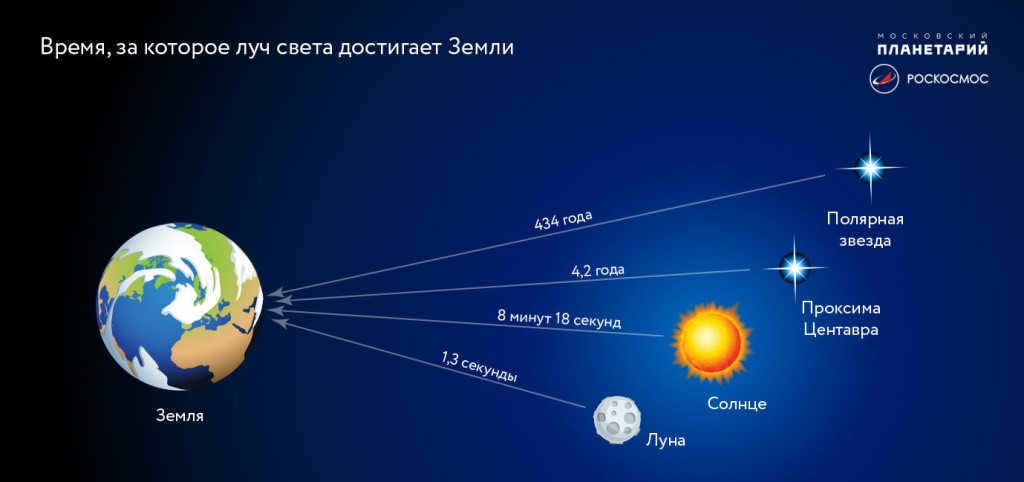
Advertisement
In the mid-1800s, French physicists Hippolyte Fizeau and Leon Foucault made two separate endeavors to approach the velocity of light at a speed of approximately 1,000 miles per second (1,609 kilometers per second).
In 1879, physicist Albert A. Michelson employed mirrors and lenses to gauge the velocity of light, which was determined to be 186,355 miles per second (299,910 kilometers per second). Four decades later, he utilized mile-long pressurized tubes in an effort to establish conditions resembling a vacuum and acquire a more precise measurement that was only marginally lower than the current accepted value.
In 1838, Friedrich Wilhelm Bessel, a physicist from Germany, utilized the speed of light to calculate the separation between Earth and the binary star system 61 Swan AB. Although he didn’t explicitly use the term “light year,” he did explain that it would take light approximately 10.3 years to traverse the distance from 61 Swan AB to Earth. This marked the first instance in which a physicist employed the light year as a means of measuring distance, thereby establishing Bessel as the individual credited with the discovery of the light year.
The expression “light year” was initially introduced in 1851 through a German publication called Lichtjare. By the time Einstein formulated the theory of special relativity (E=mc^2), which asserts that light always moves at a finite speed, the light year had already gained popularity as a unit for measuring astronomical distances among scientists.
Astronomical Units of Measurement: Light-year, Lunar Distance, and Parsec
Aside from the commonly known light-year, there are several other units used in astronomy to quantify the distances between celestial objects. These include the astronomical unit (AU), the lunar distance (LD), and the parsec (pc).
In the field of astronomy, the lunar distance refers to the average semi-major axis of the geocentric lunar orbit, representing the distance between the Earth and the Moon. This distance is roughly equivalent to 400,000 km, a quarter of a million miles, or 1.28 light seconds. The lunar distance is most frequently used to express the proximity of near-Earth objects.
On the other hand, the astronomical unit (AU) is a measurement equal to the average distance from the center of the Earth to the center of the Sun. It serves as a fundamental unit of measurement within the solar system and is particularly useful in determining the distances between planets and other celestial bodies.
The distance between objects within our solar system is commonly expressed using lunar distance and astronomical units. On the other hand, when it comes to measuring distances outside our solar system, such as distances between galaxies, light-year and parsec are the preferred units.
A parsec is defined as the distance at which the radius of Earth’s orbit creates an angle of one second of arc. This angle is formed by an arc when its two rays pass through the endpoints of that arc. In other words, the parallax of a star that is one parsec away can be measured as a one-second difference in the direction of a celestial body, as observed from two points in Earth’s orbit.
To put it into perspective, one light-year is equivalent to 63,241 astronomical units (AU), while one parsec is equal to 3.26 light-years or 206,265 astronomical units.
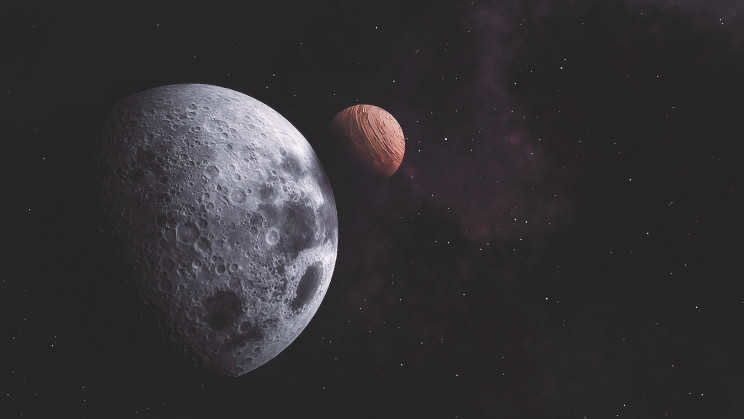
Source: CharlVera/Pixabay
Interesting Information About Light Years
Light years can be broken down into light hours, light minutes, light seconds, and even light nanoseconds. For instance, it takes eight minutes for light from the Sun to reach Earth, which means that the Sun is eight light minutes away from Earth. Here are some fascinating facts about light years:
In November 2021, the Voyager 1 space probe, which was launched by NASA in 1977, transmitted a signal from a distance of 21.31 light hours (14.45 billion miles). This is the greatest distance ever traveled in space by a human-made object.
The closest dwarf galaxy to our galaxy, the Milky Way, is the Big Dog dwarf galaxy, which is located 25,000 light-years away from the Sun. The Sagittarius dwarf elliptical galaxy is situated 70,000 light years away from the Sun. The most distant galaxy known to us is GN-z11, which was discovered by the Hubble telescope in 2016 in the constellation of the Big Dipper. At the time of its discovery, it was believed to be 13.4 billion light years away from Earth, or 134 nonillion kilometers (that’s 134 followed by 30 zeros).
A radar system that utilizes radio waves to detect airborne airplanes measures time in nanoseconds to determine the distance of the target. This is because radio waves travel at the speed of light. A nanosecond is equivalent to one billionth of a second. In a nanosecond, light travels a distance of 1 foot (30 cm).
The renowned American astronomer Edwin Hubble once famously stated: “The search will persist, it is an age-old quest, it cannot be extinguished, and it will not be subdued.” Exploration of space can also be perceived as an endeavor to uncover what exists beyond Earth and the celestial bodies. Serving as a measurement of distance, the light-year also serves as a reminder of the immense expanse of the universe and the vast amount of knowledge that humanity and science have yet to acquire.
The enormity of outer space makes it highly impractical to gauge the distance between objects scattered throughout its vastness using conventional measurements like kilometers and miles used on Earth. Astronomers employ light-years for this very purpose. Despite the inclusion of the term “years” in its name, it functions as a unit of distance rather than time.

What is a Light-year?
The concept of a light-year is quite fascinating. It represents an astronomical distance that is so immense that it is impractical to use on a small scale like our planet. To put things into perspective, the distance from the Sun to the Earth is only about 8 light minutes, while the distance to the Moon is just 1.25 light seconds. Let’s break it down further.
Imagine you leave your house (point A) and head to the store (point B). You maintain a constant speed of 4 km/h throughout the journey. Since the distance to point B is exactly 4 km, it takes you 1 hour to reach your destination.
One could describe this distance as a “human hour”, but in reality, individuals cannot maintain a constant speed, so it is not a practical unit of measurement. However, in accordance with contemporary scientific understanding, a beam of light travels at a consistent speed in a vacuum along any segment of its path.
This consistency allows for the measurement of the distance traveled by the beam of light based on the time it takes to travel. The distance that light can travel in one minute is called a light minute, and in one hour it is called a light hour, and so on.
Astronomers use light-years to measure extremely long distances. A light-year is the distance that light, traveling at a constant speed, can travel in exactly one Earth year, according to the Julian calendar (which does not account for leap years, approximately 365 and a quarter days).
Before 1984, the tropical (solar) year was used, which is the period of time it takes for the Sun to complete a full cycle of seasons. A light-year is not a unit in the international SI system.
Velocity of Light
In today’s scientific community, the velocity of light refers to the rate at which light waves travel through a vacuum. It is measured at 299,792,458 m/s or 1,079,252,848.8 km/h and is widely accepted as the ultimate limit for the movement of physical particles.
Determining the Velocity of Light
Throughout history, the prevailing belief was that light traveled instantaneously through space. However, this postulate was first challenged by the Italian scientist Galileo Galilei. The Danish astronomer Olaf Remer became the first person to accurately measure the speed of light in 1676.
He focused on the time gap between Jupiter’s satellites eclipses, which decreased as the Earth’s distance from the largest planet in the solar system decreased. The initial calculation of the speed of light provided the scientific community with a value of – 214,000 km/s. The disparity with the present-day measurement can be attributed to inaccuracies in determining the distances between planets in the 1600s.
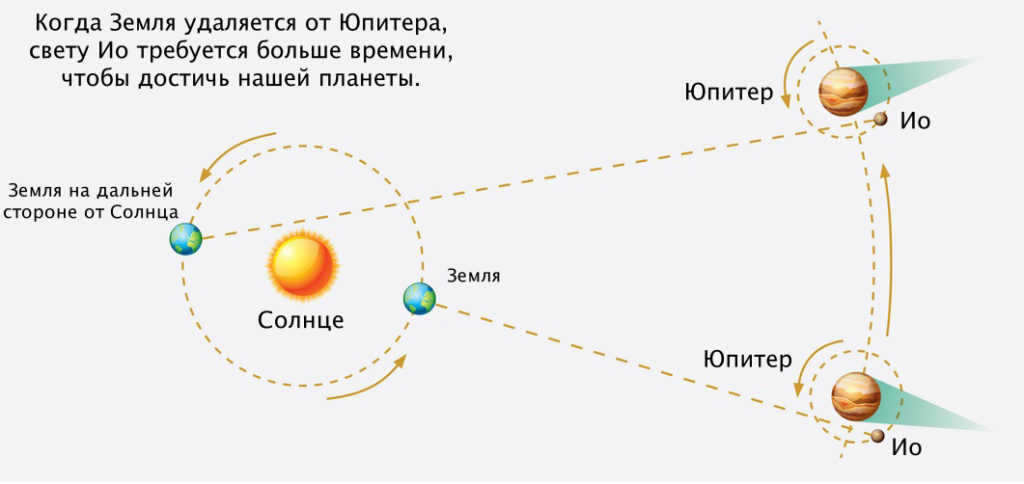
James Bradley, an English astronomer, made a significant contribution to determining the speed of light. He achieved this by observing the apparent movement of a star caused by the Earth’s orbit around the Sun. In 1728, he calculated the speed of light to be approximately 301,000 km/s.
Later, in 1849, French physicist Armand Fizeau conducted an experiment to measure the speed of light in terrestrial conditions. He directed a beam of light towards a mirror and measured its reflection after it traveled a distance of 8 km. The light beam then fell onto a rotating wheel with teeth. Fizeau’s measurements indicated that the speed of light was approximately 315,000 km/s.
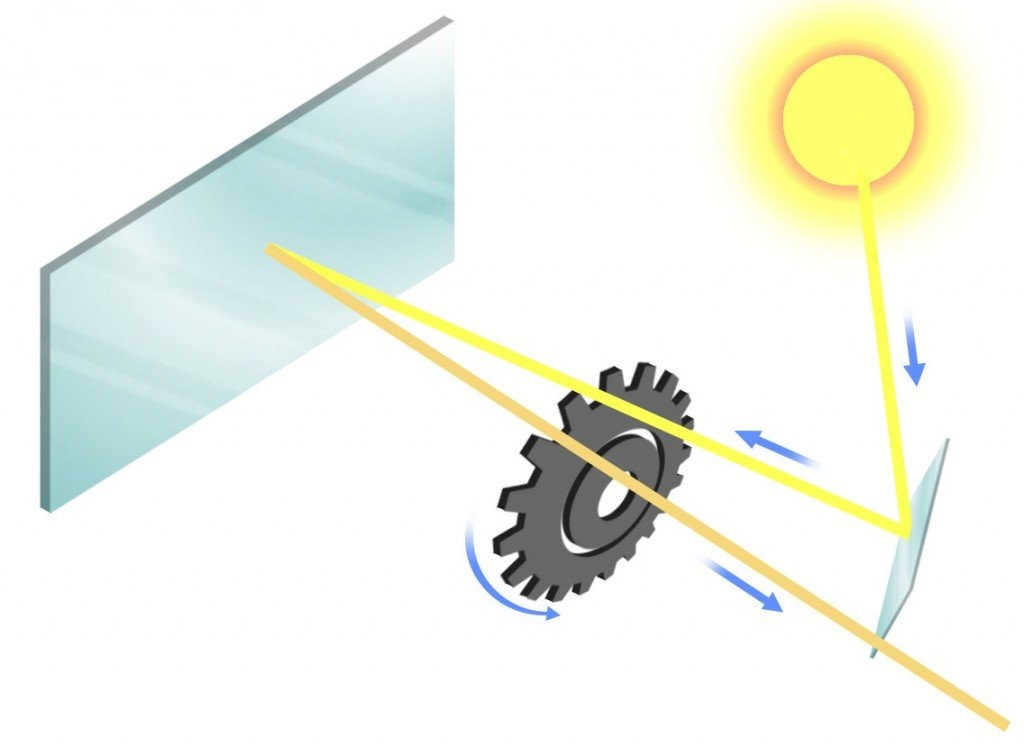
Léon Foucault, another French physicist, later enhanced the trial and attained a measurement of 298,000 km/s.
Following numerous years and numerous experiments, the ultimate fundamental constant of the velocity of light in a vacuum was officially established in 1983 during the General Conference on Weights and Measures.
How many kilometers are there in 1 light-year?
To determine the value of 1 light-year in kilometers, we need to calculate the number of hours in an Earth year. Since all years are approximately 365.25 days long, we can multiply this by 24 hours to get 8766 hours.
Next, we multiply the speed of light, which is measured in km/h, by 8766 hours. The result is 9.46 trillion kilometers. This means that it would take approximately 11 million years to travel this distance at a constant speed of 100 km/h, or 37.5 thousand years at the speed of the ISS (8 km/s).
Interestingly, this is approximately the same amount of time that modern-type humans have existed, according to archaeological evidence.
Here are some less commonly used units:
- 1 light second – 299,792.458 km;
- There are 17,987,547.48 kilometers in a minute.
- There are 1,079,252,848.8 kilometers in an hour.
- There are 25,902,068,371.2 kilometers in a day.
- There are 181,314,478,598.4 kilometers in a week.
- There are 788,394,206,048.4 kilometers in a month.
People sometimes ask how many Earth years are in a light year. It’s not really a valid question because Earth years measure time and light years measure distance.
By continuing to move at an average speed of 29,765 km/s, our planet takes approximately 10,000 years to complete one orbit around the Sun, covering a distance equal to 1 light year.
However, it is important to note that this does not mean that there are exactly 10,000 Earth years in one light year, as explained above.
A tool for converting light units to distance:
Astronomy, similar to any scientific field, possesses its own specific vocabulary that may appear peculiar and perplexing to those unfamiliar with it. What exactly does elongation mean? And perigee? Are pulsars and quasars synonymous or distinct entities? One of the inquiries frequently posed by individuals intrigued by astronomy is: what precisely is a light-year?
When it comes to the term “light-year,” it can be a bit confusing as to what exactly it measures. Is it a measure of time? If so, it would be helpful to know how long a light-year actually is. In other words, how many of our Earth years make up a light-year? On the other hand, many people have noticed that this term is often used when discussing distances to celestial objects. For instance, we might hear phrases like “the center of the Galaxy is 30000 light-years away” or “Sirius is located 8.6 light-years from us.” This raises the question of how we can measure distance using time.
Let’s attempt to simplify this and find some answers.
A light-year is a unit of measurement for distance
It is important to understand that a light-year is not a unit of time, but rather a unit of distance used in astronomy, similar to meters, kilometers, miles, or arshins in everyday life. To grasp this concept, consider how one might measure distance when a ruler or surveyor’s tool is unavailable.
As we are aware, the distance traveled by an object is equal to the object’s velocity multiplied by the time it takes to travel (or s = v × t).
Imagine you find yourself in a situation where you are required to travel to a store located exactly three kilometers away. Let’s say you decide to walk at a leisurely pace of three kilometers per hour. The question then arises: how long will it take you to reach the store? The obvious answer is one hour, as you are covering a distance of three kilometers at a speed of three kilometers per hour. In other words, the distance to the store can be quantified as one “human hour”.
However, it is important to note that nobody measures distance in “human hours” because we all have different walking speeds. Even within an individual, the walking speed can vary depending on the circumstances. For instance, someone may walk much faster when they are in a rush to catch a trolleybus, while they may take a leisurely stroll in the park. As a result, the time it takes to cover the distance to the store will always differ.
Do you ever wonder if there exists an object that moves perpetually – forever! – at a consistent pace?
The velocity of light
Indeed, there is such an object, and it is none other than light! We are aware that the velocity of light in a vacuum remains steady at 299,792 kilometers and 458 meters per second. Alternatively, rounding it off, 300,000 kilometers per second.
Therefore, in a mere second, a ray of light traverses a distance of 300,000 kilometers! Quite impressive, wouldn’t you agree? Once we figure out a way to accurately measure the exact time it takes for light to travel a certain distance, we will be able to determine its distance!
How can we accomplish this task? One approach is to utilize a high-powered laser and direct it towards the moon. As the laser beam reaches the Moon, a portion of its light will reflect off the lunar surface and travel in the opposite direction. When this light returns to Earth and enters our eyes, we will observe the formation of a luminous rabbit on the Moon. By precisely measuring the duration between activating the laser and the appearance of the bunny on the Moon’s surface, and then multiplying this time by the speed of light, we can determine the distance covered by the laser to reach the Moon and return. Dividing this total distance in half will yield the precise distance to the Moon!
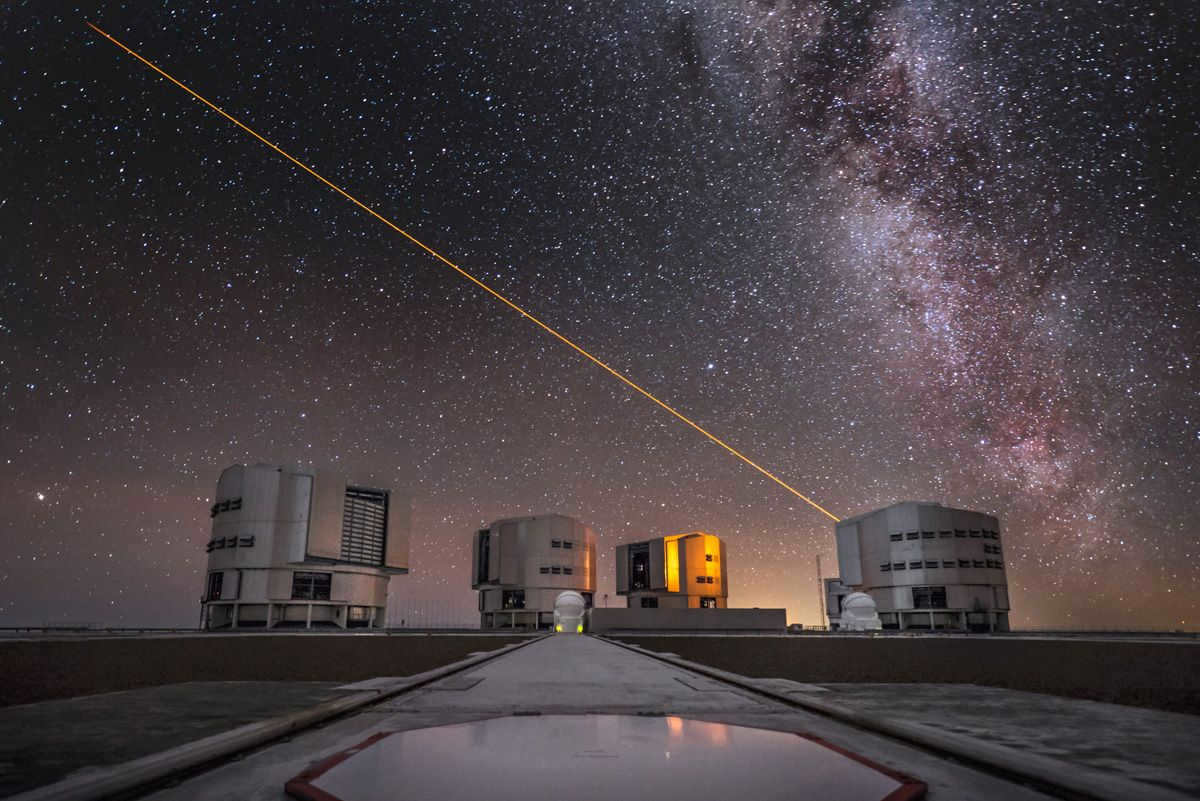
An artificial star in the sky is created by a laser beam to evaluate the condition of the atmosphere. The speed of light from this beam remains constant! However, in the atmosphere, it is slightly slower than in a vacuum. Photo: ESO
This is how astronomers in the 20th century measured various distances in the solar system. For instance, they used radar to measure the distance to Venus by sending a radio signal to the planet and waiting for its return. Radio waves travel at the speed of light, and scientists carefully measured the time of return. Then, they calculated the distance between Earth and Venus using the formula s = v × t. Today, we know this distance with an accuracy of a few meters.
Once again: why is it possible to measure distance using light? The reason is that the speed of light in a vacuum is constant! (We should mention here, in inertial reference frames.but let’s not complicate things too much.) This is unlike the speed of people, cars, and rockets.
What is a light-year?
Now let’s return to our initial question. Let’s define it: A light-year is the distance that light (always moving– always! – at a constant speed of 300,000 kilometers per second.) travels in one year exactly!
Isn’t that an enormous number? If light can cover a distance of 300 thousand kilometers in just one second, then it can cover 60 times that distance in a minute – a whopping 18 million kilometers! So, in just one hour, light will have traveled a staggering 1 billion 80 million kilometers! (Now we have a clear understanding of what a “light hour” represents! Additionally, we have successfully computed the speed of light in kilometers per hour!)
1 light-year converted to kilometers
To calculate the equivalent distance in kilometers for 1 light-year, we have to determine the number of hours in a year. A day consists of 24 hours and a year consists of 365.25 days (every fourth year is a leap year). Thus, there are 24 × 365.25 = 8766 hours in a year. (In reality, this value is slightly lower, at 8760 hours. We have rounded the number of days per year.)
Therefore, to determine the value equivalent to 1 light-year in kilometers, we need to multiply the speed of light in km/h by the number of hours in a year. This calculation results in a value of approximately 9.461 billion kilometers. Hence, 1 light-year is approximately 9.46 trillion kilometers!
That’s an astonishingly large number!
If your home were situated at this distance from the store, and you were moving at the average speed of 3 km/h, it would take you approximately 360 million years to walk there… That’s an incredibly long period, isn’t it?
It is more advantageous to opt for a car. If we were to travel at a speed of 100 km/h, a car would require a staggering 10,800,000 years to cover the distance of a light-year. This alternative is clearly not feasible. Therefore, we must consider using an airplane. In this case, an average passenger airplane would be able to cover a light-year distance in a significantly shorter time frame of 1,000,000 years.
Perhaps a rocket could provide a solution. Astronauts typically travel around the Earth at a speed of approximately 8 km/s or 28,800 km/h. However, even at this impressive velocity, it would still take them approximately 37,500 years to reach their desired destination.
What is the distance between the Sun and the Earth in light years?
Let’s now tackle the opposite problem – let’s determine the distance between the Sun and the Earth in light years. To accomplish this, we will divide the distance between the Sun and the Earth in kilometers by the length of a light year. The average distance to the Sun (also known as an astronomical unit) is 150 million kilometers, while a light year measures 9.46 trillion kilometers. Dividing the former by the latter yields 0.000016.
Therefore, the distance between the Sun and the Earth is 0.000016 light years. Alternatively… 8 light minutes.
The Sun is much farther away than the Moon, with an average distance of 384,000 kilometers or just over a light second. So, how does this distance translate to light years? Well, if we divide 384,000 km by the length of a light year (which is still the same 9.46 trillion km), we get the incredibly small number of 0.000000000041 light years. (Of course, feel free to double-check my calculation if you have any doubts.)
Clearly, it’s quite silly to measure the distance to the Moon in light years. However, this does raise an interesting question:
What is the purpose of using light-years?
The reason is straightforward: to calculate distances that are beyond the solar system!
- The Sun’s closest neighbor, Proxima Centauri, is located 4.2 light-years away. This means that light takes 4.2 years to travel the distance from the Sun to Proxima Centauri.
- Most of the stars visible in the night sky are tens or hundreds of light-years away!
- Deneb, a star in the Summer Triangle, is situated 2,500 light-years away from us.
- The center of our galaxy, known as the Milky Way, is located 30,000 light-years away.
- The Milky Way has a diameter of 100,000 light-years.
- The Andromeda Nebula, the nearest large spiral galaxy to us, is situated 2.5 million light-years away.
- The distance from Earth to the center of a large cluster of galaxies in the Virgo constellation is 65 million light-years.
- The closest quasars are located 3 billion light years away.
- Eventually, the edge of the observable Universe is nearly 14 billion light years away.
Would you like to convert these distances into kilometers? You’re not interested? Well, astronomers aren’t too keen on calculating them either.
PS. Well, there’s no way you can drive through such vast distances….
When it comes to space, the typical units of distance measurement that we use here on Earth become insignificant. The numbers become so large, filled with numerous zeros. For instance, the distance to the Sun from our planet is a staggering 150 million kilometers, while the distance to the nearest star, Proxima in the constellation of Centauri, is over 40 billion kilometers. Dealing with such enormous numbers becomes extremely challenging and difficult to comprehend. As a solution, scientists have devised a method to measure distances in space, between stars and galaxies, by using the time it takes for light to travel between these celestial bodies.
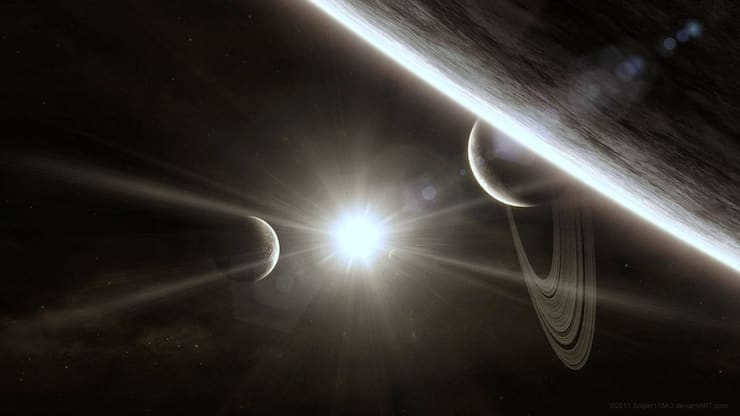

Working with these numbers makes things much simpler. For instance, it takes light only about 500 seconds, or a little over 8 minutes, to travel from the Sun to the Earth. From Proxima Centauri, it would take 4.2 years. And from the center of our galaxy, it would take approximately 25,000 years for light to reach us. By the time this photon journey began, mammoths still roamed the Earth! When considering distances between galaxies, the Andromeda Nebula, our neighbor, is 2.5 million light years away.

It’s quite astonishing to ponder the vast number of kilometers that would equate to. However, when we gaze upon this galaxy, visible even in the absence of artificial optics amidst the darkness of the night sky, we are peering into a time when our planet was still teeming with mammoths. Hence, when it comes to the vast expanse of space, the concept of light years proves to be much more practical and convenient than the familiar unit of kilometers that we employ here on Earth.
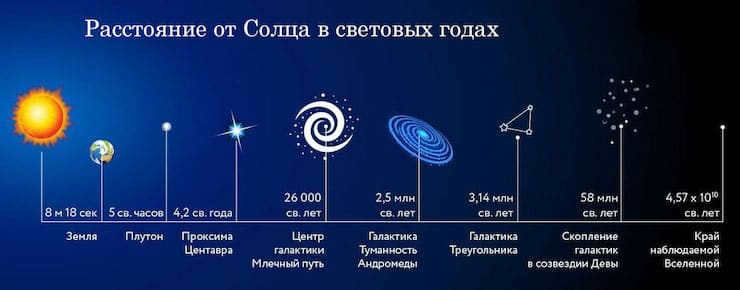
However, in most cases, cosmic distances are measured not in light years, but in parsecs. In reality, these values are quite comparable. One parsec (pc) is approximately equal to 3.26 light years, and this value is more convenient for astronomical calculations.
At a certain point, astronomers decided to determine the distance to nearby celestial objects by observing their apparent angular displacement as the Earth orbits the Sun. This measurement is known as parallax. The parallax decreases as the distance to the object increases. A parallax value of 1 angular second corresponds to a distance of 1 parsec. The term itself is a combination of the words “parallax” and “second”. For example, if the parallax value is 0.1 arc seconds, the distance is 10 parsecs.
What is the Distance of a Light-year in kilometers?
A light-year is the measurement of the distance that light can travel in a vacuum over the course of one Julian year (365.25 days or 31,557,600 standard seconds), without being affected by gravitational fields.
Conversion of Light-year to kilometers
Here are the conversions of light-year to kilometers:
1 light second = 299,792.458 km
1 light minute = 17,987,547.48 km
1 light hour = 1,079,252,848.8 km
1 light day = 25,902,068,371.2 km
1 light week = 181,314,478,598.4 km
1 light month = 788,394,206,048.4 km (equivalent to 1/12 of a light-year)
1 light-year = 9,460,730,472,580.8 km = 365.25 Earth days = 0.306601 parsecs.
What is the equivalent of a light year in Earth years?
A light year is a unit that measures distance, while an Earth year is a unit of time. It’s like asking “how many days are in 1 kilometer”.
🔥 Related Articles:
How valuable is this publication?
Click on a star to give it a rating!
Average rating 4.3 / 5. Number of ratings: 8
No ratings yet. Be the first to rate.
The measurement known as a light year pertains to distance, not time, contrary to common belief. Specifically, a light-year represents the distance that a beam of light covers within a span of one Earth year, which is roughly equivalent to 9.7 trillion kilometers. When dealing with astronomical distances on a universal scale, expressing them in kilometers becomes challenging due to the immense numerical values involved. As a result, astronomers find it more convenient to gauge the distance to stars by considering the time it takes for light to traverse that expanse. As an illustration, the nearest star to our Sun, Proxima Centauri, lies at a distance of 4.2 light-years. In other words, the light emanating from this star requires slightly over four years to reach our vantage point.

The Length of a Light Year in Kilometers
The speed of light remains constant throughout the entire universe and is known to a high degree of accuracy. In a vacuum, light travels at a speed of 299,792,458 meters per second (1,079,252,849 kilometers per hour). To calculate the distance of a light year, multiply this speed by the number of hours in a year – 8760. The result is a staggering 9.45 trillion kilometers. At first glance, this figure may seem like an unimaginable distance. However, the vastness of the universe easily surpasses this measurement. Astronomers currently estimate that the observable universe has a diameter of 93 billion light years.
What is the purpose of using light-years as a measurement?
For instance, the Orion Nebula, the nearest star-forming region to our planet, is located approximately 1,300 light-years away. Similarly, the center of our galaxy is situated at a distance of approximately 27,000 light-years. Furthermore, the Andromeda Galaxy, the closest spiral galaxy to our own, is positioned a staggering 2.5 million light-years away.
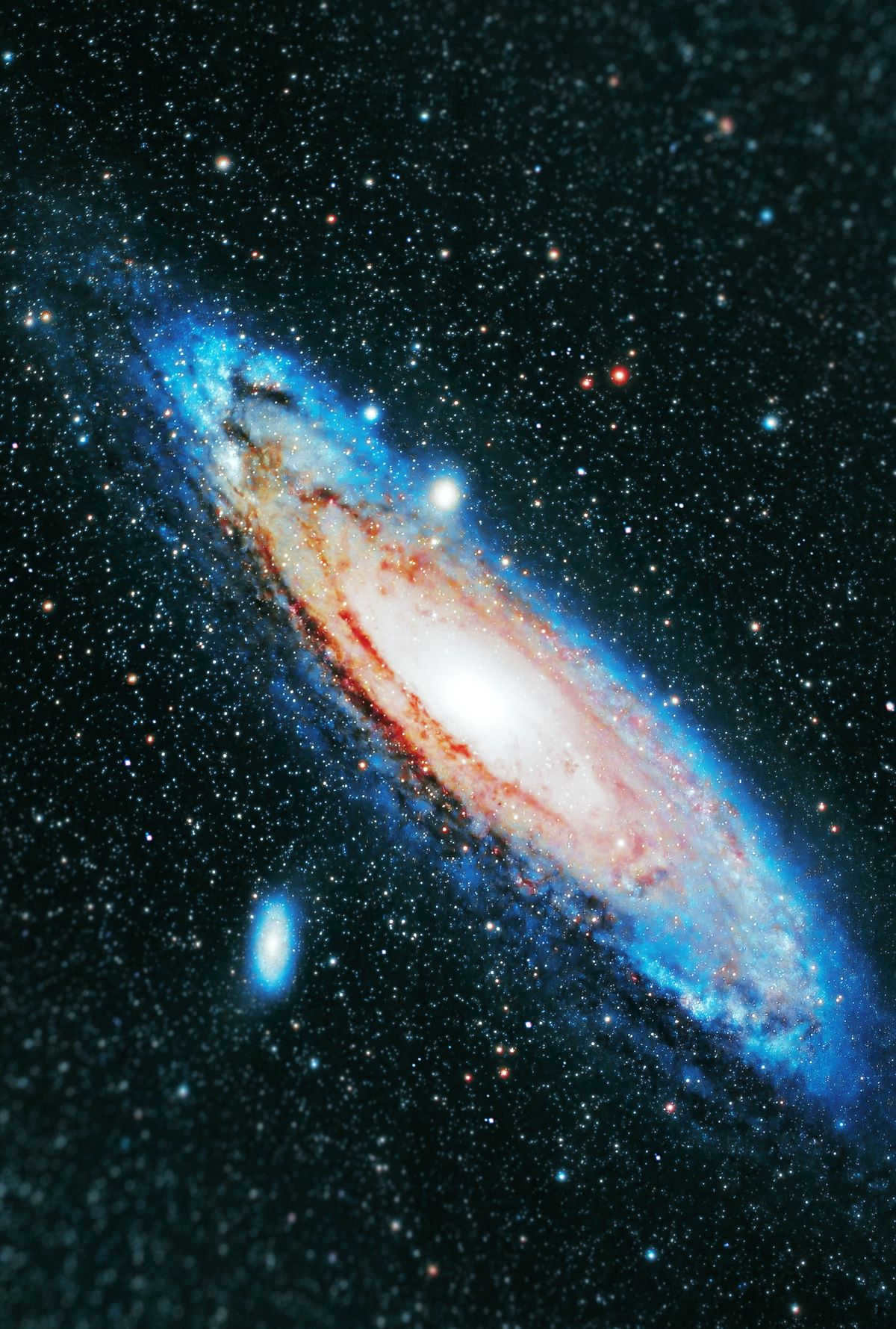
There are galaxies that can be observed that are billions of light-years away. One such galaxy is GN-z11, which is considered the most distant galaxy detectable from Earth, with a distance of 13.4 billion light-years. It is difficult to comprehend these distances when converted to regular kilometers, as the numbers become extremely large, reaching quadrillions, quintillions, and sextillions.

Similar to degrees, the light-year can be divided into smaller increments: light hours, light minutes, or light seconds. For instance, the Sun is located over 8 light minutes away from Earth, while the Moon is just a little over a light second away. These terms are commonly used by scientists when discussing communication with spacecraft and rovers. Due to the limited speed of light, it can take over 20 minutes to transmit a signal to the Curiosity rover on Mars and more than 19 hours for the Voyager spacecraft to reach the Sinhalese people.
“Time Machine.”
By using light-years as a measurement, astronomers can also ascertain the temporal distance of their observations. Since light takes time to travel to our eyes, everything we perceive in the night sky has already occurred in the past.
For instance, when we look at the Andromeda galaxy, we are essentially observing it as it appeared 2.5 million years ago. The cosmic microwave background, on the other hand, offers us the most remote and ancient glimpse into the universe, dating back approximately 13.8 billion years to the time just after the Big Bang.

The James Webb Telescope is set to aid in the observation of celestial bodies that originated during the nascent stages of the Universe, when it was merely a few hundred million years old. Existing tools provide us with insufficiently clear images of these objects.
A different unit of measurement than light-years
Instead of using light-years, astronomers have another option called parsecs. The term “parsec” is short for parallax-second, and it derives from the method of triangulation used to calculate the distance to stars. Specifically, a parsec is the distance to a star that appears to shift by 1 angular second (1/3600 of a degree) in the sky when the Earth completes half of its orbit around the Sun. This measurement is equivalent to 3.26 light-years.
It is worth mentioning that earlier scientists made a prediction about the eventual explosion of the Sun.
Stay updated with the most fascinating news and facts in our Telegram channel!
Join us at: https://t.me/ustmagazine





